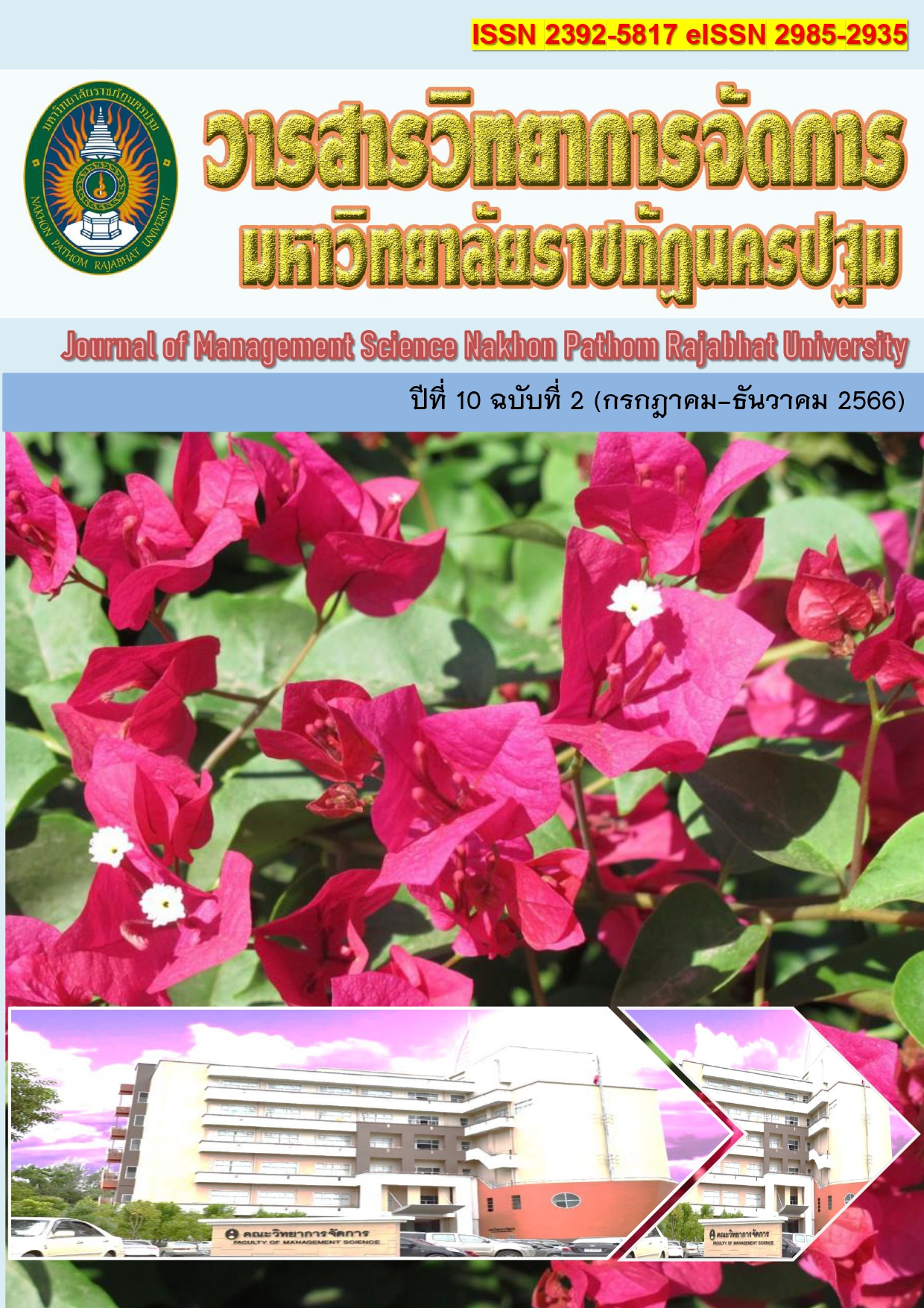ปัจจัยส่วนประสมการตลาดบริการที่มีอิทธิพลต่อการตัดสินใจซื้อเสื้อผ้าแบรนด์ยูนิโคล่ ของผู้บริโภคในเขตจังหวัดปทุมธานี
Main Article Content
บทคัดย่อ
การศึกษาครั้งนี้มีวัตถุประสงค์เพื่อศึกษาปัจจัยส่วนประสมการตลาดบริการ (7Ps) ที่มีอิทธิพลต่อการตัดสินใจซื้อเสื้อผ้าแบรนด์ยูนิโคล่ (Uniqlo) ของผู้บริโภคในเขตจังหวัดปทุมธานี กลุ่มตัวอย่างที่ใช้ในการศึกษาครั้งนี้ คือ ผู้บริโภคในเขตจังหวัดปทุมธานีที่ซื้อเสื้อผ้าแบรนด์ยูนิโคล่ 418 คน เก็บรวบรวมข้อมูลด้วยแบบสอบถาม โดยใช้วิธีการสุ่มแบบไม่อาศัยความน่าจะเป็นด้วยวิธีการสุ่มแบบเจาะจง สถิติที่ใช้ในการวิเคราะห์ข้อมูล ได้แก่ ร้อยละ ค่าเฉลี่ย ส่วนเบี่ยงเบนมาตรฐาน และแบบจำลองสมการโครงสร้างกำลังสองน้อยที่สุดบางส่วน (PLS-SEM)
ผลการวิจัยพบว่า ปัจจัยส่วนประสมทางการตลาดบริการ ได้แก่ ผลิตภัณฑ์ การส่งเสริมการตลาด และกระบวนการ มีอิทธิพลต่อการตัดสินใจซื้อเสื้อผ้าแบรนด์ยูนิโคล่ของผู้บริโภคในเขตจังหวัดปทุมธานี อย่างมีนัยสำคัญทางสถิติที่ระดับ .043, ระดับ .000, และระดับ .009 ตามลำดับ ซึ่งทั้ง 3 ตัวแปรร่วมกันทำนายได้ถึงร้อยละ 55.5
1,2,4คณะบริหารธุรกิจ มหาวิทยาลัยเทคโนโลยีราชมงคลธัญบุรี, ปทุมธานี
3นักศึกษาปริญญาเอก คณะบริหารธุรกิจ มหาวิทยาลัยเทคโนโลยีราชมงคลธัญบุรี
* Corresponding author: boontharika_w@rmutt.ac.th
Article Details

This work is licensed under a Creative Commons Attribution-NonCommercial-NoDerivatives 4.0 International License.
ทัศนะและข้อคิดเห็นของบทความที่ปรากฏในวารสารฉบับนี้เป็นของผู้เขียนแต่ละท่าน ไม่ถือว่าเป็นทัศนะและความรับผิดชอบของกองบรรณาธิการ
References
กรุงเทพธุรกิจ. (2566). สำรวจสินค้าแฟชั่น-เสื้อผ้าหลังโควิด เร่งปรับตัวครั้งใหญ่ ชูความหลากหลาย. [ออนไลน์].ค้นเมื่อ 3 เมษายน 2566 จาก https://www.bangkokbiznews.com/business/business/1062142
กฤษณะ หลักคงคา. (2564). ช่องทางการตลาดสำหรับธุรกิจค้าปลีกสมัยใหม่ในยุคโควิด-19. วารสารมหาจุฬานาครทรรศน์, 8(3), 318-336.
กฤษดา เชียรวัฒนสุข และ ศรากุล สุโคตรพรหมมี. (2559). การวิเคราะห์เพื่อจำแนกกลุ่มลูกค้าผู้ใช้บริการสายการบินต้นทุนต่ำโดยใช้ปัจจัยส่วนประสมการตลาดบริการ(7Ps). วารสารบริหารธุรกิจ เทคโนโลยีมหานคร, 13(1), 92-109.
ชิสา สุวรรณนาวิน. (2564). การศึกษาแนวโน้มแฟชั่นเพื่อออกแบบคอลเล็คชั่นเสื้อผ้า. วารสารศิลปกรรมศาสตร์วิชาการ วิจัย และงานสร้างสรรค์, 8(1), 252-273.
ธโนทัน มงคลสินธุ์. (2556). สื่อสังคมออนไลน์กำลังเปลี่ยนแปลงอุตสาหกรรมแฟชั่นได้อย่างไร.วารสารสถาบันวัฒนธรรมและศิลปะ มหาวิทยาลัยศรีนครินทรวิโรฒ, 15(1), 1-15.
ปฏิพาร์ เพรชศิริ สิริวัฒน์ สุขศรีสวัสดิ์ ศิรินทิพย์ เหลืองสุดใจชื้น ศิลป์ชัย เกษฒเทวินทร์ สวรรยา รักอาชีพ และวิโรจน์ เจษฎาลักษณ์. (2560). รูปแบบและกลยุทธ์เพื่อสร้างความได้เปรียบในการแข่งขันของธุรกิจเสื้อผ้าค้าส่งในตลาดโบ๊เบ๊ กรุงเทพมหานคร. Veriadian E-Journal, Silpakorn University, 10(2), 517-530.
ประสพชัย พสุนนท์. (2558). ความเที่ยงตรงของแบบสอบถามสำหรับงานวิจัยทางสังคมศาสตร์. วารสารสังคมศาสตร์ มหาวิทยาลัยศรีนครินทรวิโรฒ, 18, 375-396.
พิษณุ อิ่มวิญญาณ และพนิต กุลศิริ. (2558). การจัดการร้านค้าปลีกที่มีอิทธิพลต่อพฤติกรรมการซื้อสินค้าของผู้บริโภค: กรณีศึกษา ร้านสะดวกซื้อในกรุงเทพมหานคร. วารสารวิจัยและพัฒนา วไลยอลงกรณ์ ในพระบรมราชูปภัมภ์, 10(3), 349-359.
ลงทุนแมน. (2560). HandM.UNIQLO.ZARA. [In Thai]. [ออนไลน์].ค้นเมื่อ 3 เมษายน 2566 จาก https://www.longtunman.com/1933
สถาบันพัฒนาอุตสาหกรรมสิ่งทอ. (2566). ความท้าทายและโอกาสของอุตสาหกรรมเครื่องแต่งกาย ในปี 2566. [ออนไลน์].ค้นเมื่อ 3 เมษายน 2566 จาก https://www.thaitextile.org/th/insign/detail.3326.1.0.html
สถาบันพัฒนาอุตสาหกรรมสิ่งทอ. (2566). สถานการณ์อุตสาหกรรมสิ่งทอและเครื่องนุ่งห่มไทย เดือนพฤษภาคม 2566. [ออนไลน์].ค้นเมื่อ 11 พฤษภาคม 2566 จาก https://www.thaitextile.org/th/insign/detail.3603.1.0.html
อริญชัย วีรดุษฎีนนท์. (2564). สรุป 10 ปี UNIQLO มีอะไรเกิดขึ้นบ้าง แล้วก้าวต่อไปคืออะไร. [ออนไลน์].ค้นเมื่อ 3 เมษายน 2566 จาก https://www.gqthailand.com/style/article/uniqlo-thailand-10th-anniversary
อิทธิพงษ์ ชละธาร และ พัชร์หทัย จารุทวีผลนุกูล. (2564). ส่วนประสมการตลาดและคุณค่าตราสินค้าที่ส่งผลต่อการตัดสินใจซื้อเสื้อผ้าตรายูนิโคล่ผ่านช่องทางออนไลน์ของผู้บริโภคในประเทศไทย. วารสารสมาคมนักวิจัย, 26(1), 16-29.
อิราวัฒน์ ชมระกา. (2565). ปัจจัยส่วนประสมทางการตลาดบริการที่ส่งผลต่อการตัดสินใจซื้อเสื้อผ้าและเครื่องแต่งกายแฟชั่นผ่านช่องทางการตลาดแบบออนไลน์ของประชาชนในจังหวัดอุตรดิตถ์. วารสารลวะศรี มหาวิทยาลัยราชภัฏเทพสตรี, 6(1), 106-125.
Ab Hamid, M. R., Sami, W., and Sidek, M. M. (2017). Discriminant validity assessment: Use of Fornell and Larcker criterion versus HTMT criterion. Journal of Physics: Conference Series, 890(1), 012163.
Agoe, P. (2021). Not Just Clothes: The Importance of Traditional Clothes to Ghanaians in Oldenburg. Ghana Studies, 24(24), 17-41.
Blut, M., Teller, C., and Floh, A. (2018). Testing retail marketing-mix effects on patronage: A meta-analysis. Journal of retailing, 94(2), 113-135.
Brand Inside. (2018). ไมเนอร์ดึงแบรนด์ OVS เติมพอร์ต Fast Fashion ท้าชน UNIQLO/HandM [ออนไลน์].ค้นเมื่อ 3 เมษายน 2566 จาก https://brandinside.asia/minor-ovs-fast-fashion/
Brand Inside. (2021). จับกระแส Fast Fashion เมื่อ Topshop ออกจากตลาดไทย แล้วใครจะขึ้นมาแข่ง Uniqlo-Zara-HandM. [In Thai]. [ออนไลน์].ค้นเมื่อ 3 เมษายน 2566 จาก https://brandinside.asia/fast-fashion-thailand-2021/
Bujang, M. A., Omar, E. D., and Baharum, N. A. (2018). A review on sample size determination for Cronbach’s alpha test: a simple guide for researchers. The Malaysian journal of medical sciences: MJMS, 25(6), 85.
Chaiwong, P., and Pokpermdee, P. (2016). Communication characteristics of a global brand’s store staff as a key CRM tool, and local customers’ satisfaction and intention to repurchase: A case study of UNIQLO Thailand. Journal of Communication Arts, 34(3), 79-92.
Cohen, J. B., Pham, M. T., and Andrade, E. B. (2018). The nature and role of affect in consumer behavior. In Handbook of consumer psychology (pp. 306-357). Routledge.
Darmawan, D., and Grenier, E. (2021). Competitive Advantage and Service Marketing Mix. Journal of Social Science Studies (JOS3), 1(2), 75-80.
Fouad, H., and Kortam, W. (2017). The impact of perceived quality of after-sale services on post-purchase evaluation outcomes of passenger automobiles customers in Egypt. International Journal of Business and Emerging Markets, 9(2), 148-173.
Henseler, J., Hubona, G., and Ray, P. A. (2016). Using PLS path modeling in new technology research: updated guidelines. Industrial management and data systems, 116(1), 2-20.
Hill, N., and Alexander, J. (2017). The handbook of customer satisfaction and loyalty measurement. Routledge.
Khan, S. N. (2014). Qualitative Research Method—Phenomenology. Asian Social Science, 10, 298-310.
Kotler, P., and Keller, K. L. (2016). Marketing Management (14th ed.). Shanghai: Shanghai People’s Publishing House.
Kotler, P., Kartajaya, H., and Setiawan, I. (2016). Marketing 4.0: moving from Traditional to Digital. John Wiley and Sons.
Kotler, P., and Armstrong, G. (2021). Principles of Marketing. 8th Edition. Pearson Education.
Marketeer. (2018). คุณเริ่มเบื่อ Fast Fashion หรือยัง แล้ว Uniqlo กับ HandM จะแข่งอย่างไร. [In Thai]. [ออนไลน์].ค้นเมื่อ 3 เมษายน 2566 จาก https://marketeeronline.co/archives/11059
Nilssen, R., Bick, G., and Abratt, R. (2019). Comparing the relative importance of sustainability as a consumer purchase criterion of food and clothing in the retail sector. Journal of Brand Management; London, 26(1), 71-83.
Oh, T. T., Keller, K. L., Neslin, S. A., Reibstein, D. J., and Lehmann, D. R. (2020). The past, present, and future of brand research. Marketing Letters, 31, 151-162.
Rahman, M. S., Hossain, M. A., Hoque, M. T., Rushan, M. R. I., and Rahman, M. I. (2021). Millennials’ purchasing behavior toward fashion clothing brands: influence of brand awareness and brand schematicity. Journal of Fashion Marketing and Management: An International Journal, 25(1), 153-183.
Sarstedt, M., Ringle, C. M., and Hair, J. F. (2021). Partial least squares structural equation modeling. In Handbook of market research (pp. 587-632). Cham: Springer International Publishing.
Sudari, S., Tarofder, A., Khatibi, A., and Tham, J. (2019). Measuring the critical effect of marketing mix on customer loyalty through customer satisfaction in food and beverage products. Management Science Letters, 9(9), 1385-1396.
Tarnanidis, T., Owusu-Frimpong, N., Nwankwo, S., and Omar, M. (2015). Why we buy? Modeling consumer selection of referents. Journal of Retailing and Consumer Services, 22, 24-36.
Twigg, J. (2018). Why clothes matter: the role of dress in the everyday lives of older people. In Ageing in Everyday Life (pp. 181-196). Policy Press.
Xue, L., Parker, C. J., and Hart, C. A. (2022, April). AR In-Store Solutions for Different Fashion Retail Environments: Retailers’ Perspectives. In International XR Conference (pp. 39-51). Cham: Springer International Publishing.

